Can We Stop Arguing About the “Right Way” to Be a Disability Activist?
There is more than one way to do disability activism. This should be obvious, but needs repeating.
There are plenty of internal arguments inside the disability community, about race, gender, sexual orientation, age, social class, and disability type, not to mention several vastly different philosophies of disability itself. These disagreements can be upsetting, but at least they reflect important differences with real-life consequences. And when we are at our best, we come out of these arguments wiser and more humane.
Sadly, over the last year or so, a more annoying and wasteful conflict has emerged over what counts as “real” disability activism.
The main divide seems to be between activists who mainly work online, and those who participate in events and actions in person. Some of us choose one approach or the other because we like it, or simply because we are better at it. Others of us must choose to do what our own disabilities and circumstances allow. So it is a also a clash between people whose disabilities and supports allow them to travel and undertake tiring activities, and those whose disabilities and relative lack of resources make “in person” activities difficult or impossible. This, in turn, intensifies the ongoing debate between different views of disability itself. Is disability an adaptable social condition, or is there still an irreducible medical component that can’t always be shrugged off?
One side is quick to judge others for a supposed lack of seriousness or commitment. The other side is quick to take offense when certain kinds of activism are praised, and others ignored or disparaged. Shade is thrown. Motives are assumed.
But such debates aren’t entirely pointless. Online activism can be fleeting and superficial, and it’s sometimes hard to know for sure how effective it is. Meanwhile, traditional political action can be self-indulgent. It’s high on spectacle and empowerment, but sometimes the drama of live protest overshadows its goal. But what’s frustrating is that the disability community should be able to resolve this kind of conflict better than anyone.
Here are 20 different ways you can be a disability activist:
- Participate in protests and demonstrations on disability issues.
- Analyze and develop policy proposals, and help explain them to the disability community and the general public.
- Organize disability activists in your home community.
- Join and / or donate to disability organizations you like.
- Respond to action alerts on disability issues.
- Call, text, and / or write personal letters on disability issues to elected officials.
- Meet in person with elected officials to inform them on disability issues.
- Use Facebook, Twitter, and other social media to communicate with elected officials and candidates, while amplifying disability issues to the wider community.
- Repost disability issue articles and alerts by others to your social media spaces.
- Make artwork and shareable graphics for disability activism projects.
- Help manage online disability discussions and forums.
- Write editorials on disability issues and distribute them through blogging, freelance writing, and / or social media.
- Write letters to the editor of your local newspaper.
- Join other social justice movements, like environmentalism, the Women’s March, Black Lives Matter, etc., and help make them more accessible and disability-conscious.
- Attend city, town, or village meetings to monitor and comment on local disability issues.
- Document physical barriers to people with disabilities through photos and / or accessibility mapping applications.
- Report physical barriers to business owners, and give them practical suggestions on how to fix them.
- Report violations of disability rights laws to relevant authorities and follow up for further action.
- Volunteer for candidates and / or organizations you like and offer yourself as a resource specifically on disability matters.
- Talk about disability issues with friends, family, classmates, and coworkers.
Any of these activities can be useful and productive, as long as they are done with integrity. Each approach supports all the others, and they are all essential to achieving our shared disability goals. They all count as disability activism.
There will always be people in the disability community who feel compelled to point out how other disabled people are “doing it wrong,” especially when it comes to something as important as disability activism. But it might help if we can all relax a bit, and each evaluate our own activities for ourselves. How can we do this?
- Stop implying that some kinds of disability activism are inferior to others, and make a habit of recognizing the kinds of activism that don’t get much recognition.
- Choose the disability activism that matches your talents, interests, disabilities, and resources, without worrying about what other people think.
- Be proud of what you do, no matter what. Don’t automatically interpret praise and excitement for one kind of activism as an insult to yours.
This should not be difficult. After all, if the disability community can’t agree to embrace doing things in a variety of different ways, then what’s the point of it?
About Rooted In Rights
Rooted in Rights exists to amplify the perspectives of the disability community. Blog posts and storyteller videos that we publish and content we re-share on social media do not necessarily reflect the opinions or values of Rooted in Rights nor indicate an endorsement of a program or service by Rooted in Rights. We respect and aim to reflect the diversity of opinions and experiences of the disability community. Rooted in Rights seeks to highlight discussions, not direct them. Learn more about Rooted In Rights




Excellent list of activism activities. I agree, there’s no ‘right’ way to be an activist. Doing something is better than doing nothing, and your ‘activity’ (whatever it might be) could be the one action that tips the scales in getting a needed change to occur.
#21 Run for elected office!
Thank you – I tend not to think of one side versus another but I do understand there are differences of opinion – what is the biggest problem in my mind is the silencing if those who may have a different opinion. Censoring and blocking those advocates who have a different opinion or who ask for clarification of research and facts is discrimination.
I’m not sure I’d call it “discrimination,” but it’s certainly unfortunate in many cases. That said, while I think that disability activism should be open to all methods, I think it may be legitimate to place some boundaries on the content of what can properly be called “disability activism.” I’m thinking a lot about that, and may try to write about it in the future.
I think it’s plenty legitimate, you just have to be careful where you’re drawing the boundaries and why. Lots of things that are never considered disability activism (especially those engaged in within institutions, and/or by people who aren’t considered to have any legitimate voice) should count. But there’s also a school of thought that says if you feel good and/or righteous and/or something while you’re doing something then it’s automatically activism — this goes far beyond the disability community. And I have a problem with that way of thinking. Like… activism can take many forms, including many unexpected to the average person (or even the average disabled person). But it doesn’t mean that you can just randomly call something activism and have it magically be activism because you feel like it, either.
Excellent. 21. One could run for office!
Thank you for your article. I appreciate the “naming” and acknowledging of the tension that sometimes occur. A recommendation to those who organize or do outreach only online, try to organize the old fashion way too (phone calls, postcards, notification at community centers). Not everyone has the privilege to access the internet, or find it particularly accessible. Thank you again!
I think the problem here is that not everyone can do activism that’s NOT on the internet. The solution is not that everyone should do everything, but that if we all do what we are able to do and able to do well, then all bases will be covered. People who can do it the “old fashioned way” take care of that end, and those who can do it on the internet will take care of the other end. We get into judgmental modes when we see a type of activity we either can’t access ourselves, or just basically don’t LIKE. So I’ve not only seen “old fashioned” activists disparage online activism … I’ve also seen online activists disparage phone calling, visiting legislators, and public protesting. The point is it’s all good, all necessary, and all worth doing.
Not all of us can do pain calls, or have accessible community centers. I have trouble just doing online petitions, because many politicians require pain numbers for each signature.
Here, as in any other progressive community, people dropping their false sense of moral superiority will do a lot to help us unite to create the kind of world we all can live in.
To your list I would add publicly support candidates that support the disabled community. Go vote for these candidates or at least vote for candidates that will not work to erode the gains that have been made. If every disabled person registered and voted we could become a force to be reckoned with.
Thanks so much to everyone who has commented so far!
I think a big issue related to disabled advocacy is the lack of indigenous (Native American and SOME Latinos) or African descent males especially those with ID/DD. So many disabled rights blogs and protest are related to white females in wheelchairs and with Down syndrome. You cannot have social justice without thinking of the most oppressed groups minority males. Of those who are victims of police brutality the most common demographic is mentally ill or developmentally disabled black and native american males. Also most of those people in jail and those who are homeless have very similar statistics.